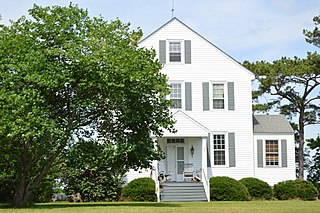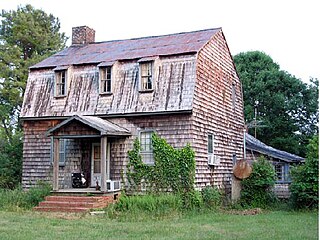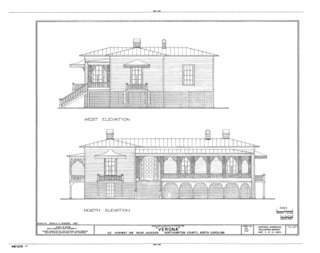
Edenton Historic District is a national historic district located at Edenton, Chowan County, North Carolina. The district encompasses 342 contributing buildings, 4 contributing sites, and 3 contributing structures. It includes several buildings that are individually listed on the National Register. The Lane House, possibly the oldest surviving house in North Carolina, is owned by Steve and Linda Lane and is located within the district. Also located in the district are the Dixon-Powell House, William Leary House, and Louis Ziegler House designed by architect George Franklin Barber.
The Humphrey–Williams Plantation is a historic plantation complex located near Lumberton, Robeson County, North Carolina. The Humphrey–Williams House was built about 1846 with the forced labor of enslaved people, and is a two-story, five bay, vernacular Greek Revival style frame farmhouse. It features a one-story, full-width shed porch. Also on the property are the contributing William Humphrey House, Annie Fairly's House, tobacco barn, a carriage house, a smokehouse, a store-post office (1835-1856), and the agricultural landscape.

The Fountain, also known as Walnut Fountain and the Colonel Davenport House, is a historic plantation home located at Yadkin Valley, Caldwell County, North Carolina. It was built in 1807, and is a two-story, "T"-shaped frame dwelling with Federal and Greek Revival style design elements. Also on the property is a contributing brick well house/dairy.
Brown–Graves House and Brown's Store is a historic plantation complex located near Locust Hill, Caswell County, North Carolina. The plantation house was built about 1800, and is a two-story, five bay, Late Georgian style frame dwelling. It is set on a stone basement and has a low hipped roof. The front facade features a one-story pedimented porch with Corinthian order columns. Brown's Store is located across from the house and is a one-story, gabled frame building with a single shouldered stone and brick chimney. Also on the property are the contributing two slave quarters, a smoke house, and a Greek Revival period law office.

Culong, also known as the Thomas Cooper Ferebee House and Forbes House, is a historic home located near Shawboro, Currituck County, North Carolina. It was built in 1812, and is a two-story, three bay by three bay, Federal style frame dwelling with a gable roof. It has two wing additions and a one-story front portico. Also on the property are two contributing outbuildings and family cemetery.

Bracebridge Hall is a part of historic farm, the house is part of a former former plantation and is a registered national historic district located near Macclesfield, Edgecombe County, North Carolina. The district encompasses eight contributing buildings, two contributing sites, and three contributing structures associated with the Bracebridge Hall. The original house was built about 1830–1832, and enlarged about 1835–1840, 1880–1881, and 1885. It is a two-story, five bay, weatherboarded frame dwelling with Greek Revival and Victorian style design elements. It features a one-story Doric order portico. Also on the property are the contributing Metal boiler/basin, Plantation Office, Servants’ House, Tobacco Barn, Troughs, Large Barn, Barn, Overseer's House, Carr Cemetery (1820), and the Agricultural landscape. Buried in the cemetery is North Carolina Governor Elias Carr (1839-1900) and his wife Eleanor Kearny Carr (1840–1912).
Baker Farm, also known as Perdue Farm, is a historic home and farm complex located near Bunn, Franklin County, North Carolina. The house was built in the first quarter of the 19th century and renovated in 1856 in the Greek Revival style. It is a two-story, three bay frame dwelling with a late-19th century two-story rear wing. Also on the property are 10 contributing outbuildings including a smokehouse, wash house, two barns, a storage shed, and three tobacco barns.

Shemuel Kearney House was a historic plantation house located near Franklinton, Franklin County, North Carolina, formerly at 2555 U.S. Highway 1 south of town. In 2009, the house was dismantled and moved to nearby Louisburg for restoration as the original property was recently zoned by Franklin County for commercial use. Therefore, the building had to be relocated. The Shemuel Kearney House was reconstructed next to another historic residence, the Cooke House, on Peach Orchard Road in 2015.

Green Hill House is a historic plantation house located near Louisburg, Franklin County, North Carolina. It was built prior to 1785, and is a 1+1⁄2-story, three bay, Georgian style frame dwelling. It sits on a raised basement and has a rear shed extension. The house features large double-shoulder brick end chimneys. Green Hill (1741-1828) was active in the Methodist movement and his house was the scene in 1785 of the first annual conference of the newly organized Methodist Episcopal Church, attended by Bishop Francis Asbury and Bishop Thomas Coke.
Dean Farm is a historic farm complex and national historic district located near Louisburg, Franklin County, North Carolina. The district encompasses two contributing buildings, one contributing site, and two contributing structures. The farmhouse was built about 1842, and is a two-story, three bay, Federal / Greek Revival style frame dwelling. It has a gable roof and two large single-shoulder gable-end chimneys of large stone blocks. Also on the property are the contributing smokehouse, corn crib, harness room, and family cemetery.

Person–McGhee Farm is a historic farm complex located at 5631 U.S. Highway 1 in Franklinton, Franklin County, North Carolina, about 4 miles north of town. The earliest section of the house was built sometime between 1770 and 1820, and is a three-bay, two-story frame dwelling over a stone-walled cellar. It has double shouldered brick end chimneys. In the 1890s, a large 2 1/2-story Queen Anne / Colonial Revival style section was added to the original Federal period dwelling. Also on the property are the contributing tenant house (1860s-1870s), a water tower, smokehouse, cattle barn, three log tobacco barns, and several sheds.
Massenburg Plantation, also known as Woodleaf Plantation, is a historic plantation house located near Louisburg, Franklin County, North Carolina. The property encompasses 10 contributing buildings, 1 contributing site, and 1 contributing structure. The main house reached its present form in 1838, and is a simple two-story L-shaped dwelling, with a rear two-story wing. It is four bays wide and features a stone block chimney. The property is currently owned by Travis Massenburg. The property also includes the contributing plantation office, smokehouse, cotton gin, storage building, hen house, 1+1⁄2-story Perry House bungalow, and Overseer's House ruins.

Williamson House is a historic home located at Louisburg, Franklin County, North Carolina. It was built about 1855, and is a one-story, three bay by two bay, Greek Revival style frame cottage dwelling. It has a hipped roof and rests on a brick basement.

Fuller House is a historic home located at Louisburg, Franklin County, North Carolina. It was built in 1856, and is a two-story, three bay by two bay, Greek Revival style frame dwelling. It has a hipped roof and rests on a low foundation of stone blocks. The front facade features a full width front porch. It was the home of noted poet and novelist Edwin Wiley Fuller (1847–1876).
Rose Hill, later known as Timberlake House, is a historic plantation house located near Louisburg, Franklin County, North Carolina. The main block was built about 1803, and is a two-story, five bay, transitional Georgian / Federal style frame dwelling. It has a gable roof and double-shouldered brick end chimneys. A rear ell was expanded about 1840, and about 1880 a one-story Queen Anne-style, full width verandah was added. About 1910, a Neoclassical portico was added over the verandah, as was a bathroom wing. Also on the property are the contributing slave quarter, kitchen, playhouse, and generator / wellhouse.

Louisburg Historic District is a national historic district located at Louisburg, Franklin County, North Carolina. The district encompasses 206 contributing buildings, 1 contributing site, 6 contributing structures, and 1 contributing object in residential sections of Louisburg included in the original 1779 town plan. It also includes a section of Louisburg College located on the old Town Commons. Dwellings date between about 1800 and the 1920s and include notable examples of popular architectural styles including Federal / Georgian, Italianate / Greek Revival, Queen Anne, Colonial Revival, Late Victorian, and Bungalow / American Craftsman. Located in the district and separately listed are the Fuller House, Williamson House, and Main Building, Louisburg College. Other notable buildings include the Shine-King House, Milner-Perry-Boddie-Dennis House, Dr. J.B. Clifton House, The Edgerton-Pruitt House, The Furgurson-Hicks House, Nicholson-Bickett-Taylor House, The Hughes-Watson-Wheless House, Bailey-Yarborough House, The Barrow House, The Neal-Webb House, The Milner-Williams-Person Place, Former Rectory-St. Paul's Episcopal Church, Hicks-Perry-Bland-Holmes House, Malcomb McKinne House First Baptist Church (1927), Louisburg United Methodist Church (1900), and Louisburg Baptist Church (1901-1904).
Obediah Winston Farm is a historic tobacco farm complex and national historic district located near Creedmoor, Granville County, North Carolina. The farmhouse was built about 1855, and is a two-story, five bay, Greek Revival style heavy timber frame dwelling. Also on the property are the contributing log outbuilding, slave house, potato house, stable, smokehouse, packhouse, tobacco barn, and tenant house.

Verona is a historic plantation house located near Jackson, Northampton County, North Carolina. It was built about 1855, and is a one-story, six bay, "T"-shaped, Italian Villa style frame dwelling. It has a hipped roof, is sheathed in weatherboard, and sits on a brick basement. It features a full-width porch, with flat sawnwork posts and delicate openwork brackets. Also on the property is the contributing family cemetery. The house was built for Matt Whitaker Ransom (1826-1904), Confederate brigadier general, United States senator, and minister to Mexico, and his wife Martha Exum.
Avirett–Stephens Plantation is a historic slave plantation complex and national historic district located near Richlands, Onslow County, North Carolina. The plantation house was built in 1851, and is a two-story, five bay, double-pile Greek Revival style frame dwelling. It is sheathed in pine board-and-batten and sits on a brick pier foundation. It features a wide two-tiered porch with a shallow hipped roof. Other contributing resources are antebellum cistern, family cemetery, and surrounding farmland.
Isaac Williams House is a historic home located near Newton Grove, Sampson County, North Carolina. The farmhouse was built about 1867, and is a one-story, double-pile, five bay-by-four bay, transitional "Triple-A" frame dwelling, with Greek Revival style design elements. It has a prominent front cross-gable roof and hip roofed, three bay, front porch. A 1+1⁄2-story rear ell was added about 1980. Also on the property are the contributing servants quarters, family cemetery, and surrounding fields and woodlands.















